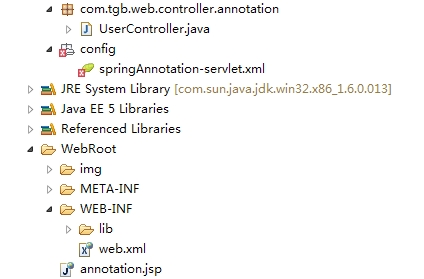之前一篇文章讲的的是基于xml配置spring mvc,这种方式基本被遗弃,现在主流都是使用基于注解配置的。
1.先看看文件目录结构

2.配置web.xml
1 <?xml version="1.0" encoding="UTF-8"?> 2 <web-app version="2.5" 3 xmlns="http://java.sun.com/xml/ns/javaee" 4 xmlns:xsi="http://www.w3.org/2001/XMLSchema-instance" 5 xsi:schemaLocation="http://java.sun.com/xml/ns/javaee 6 http://java.sun.com/xml/ns/javaee/web-app_2_5.xsd"> 7 <welcome-file-list> 8 <welcome-file>index.jsp</welcome-file> 9 </welcome-file-list> 10 <!--springmvc 入口配置 start --> 11 <servlet> 12 13 <servlet-name>springMVC</servlet-name> 14 15 <servlet-class>org.springframework.web.servlet.DispatcherServlet</servlet-class> 16 <init-param> 17 <param-name>contextConfigLocation</param-name> 18 <param-value>classpath*:config/springAnnotation-servlet.xml</param-value> 19 </init-param> 20 <load-on-startup>1</load-on-startup> 21 22 </servlet> 23 24 <servlet-mapping> 25 26 <servlet-name>springMVC</servlet-name> 27 28 <url-pattern>/</url-pattern> 29 30 </servlet-mapping> 31 </web-app>
3.编写控制器.
1 package com.tgb.web.controller.annotation; 2 3 import org.springframework.stereotype.Controller; 4 import org.springframework.web.bind.annotation.RequestMapping; 5 import org.springframework.web.bind.annotation.RequestMethod; 6 import org.springframework.web.servlet.ModelAndView; 7 8 @Controller 9 @RequestMapping("/user") 10 public class UserController { 11 12 @RequestMapping(value="/addUser",method=RequestMethod.GET) 13 public ModelAndView addUser(){ 14 String result="addUser"; 15 return new ModelAndView("/annotation","result",result); 16 } 17 18 @RequestMapping(value="/delUser",method=RequestMethod.GET) 19 public ModelAndView delUser(){ 20 String result="delUser"; 21 return new ModelAndView("/annotation","result",result); 22 } 23 }
4.配置springAnnotaion-servlet-xml
1 <?xml version="1.0" encoding="UTF-8"?> 2 <beans xmlns="http://www.springframework.org/schema/beans" 3 xmlns:context="http://www.springframework.org/schema/context" 4 xmlns:xsi="http://www.w3.org/2001/XMLSchema-instance" 5 xmlns:mvc="http://www.springframework.org/schema/mvc" 6 xsi:schemaLocation="http://www.springframework.org/schema/mvc 7 http://www.springframework.org/schema/mvc/spring-mvc-3.0.xsd 8 http://www.springframework.org/schema/context 9 http://www.springframework.org/schema/context/spring-context.xsd 10 http://www.springframework.org/schema/beans 11 http://www.springframework.org/schema/beans/spring-beans-3.0.xsd"> 12 13 <!-- 配置扫描包,spring启动的时候会在这个包里面扫描 --> 14 <context:component-scan base-package="com.tgb.web.controller.annotation"></context:component-scan> 15 <!-- 开启注解 --> 16 <mvc:annotation-driven/> 17 <!-- 18 <bean class="org.springframework.web.servlet.mvc.annotation.AnnotationMethodHandlerAdapter"/> 19 <bean class="org.springframework.web.servlet.mvc.annotation.DefaultAnnotationHandlerMapping"/> 20 --> 21 22 <bean id="viewResolver" class="org.springframework.web.servlet.view.InternalResourceViewResolver"> 23 <property name="prefix" value="/"/> 24 <property name="suffix" value=".jsp"/> 25 </bean> 26 <!-- 静态资源访问 --> 27 28 <mvc:resources location="/img/" mapping="/img/**"/> 29 <mvc:resources location="/js/" mapping="/js/**"/> 30 <mvc:resources location="/css/" mapping="/css/**"/> 31 32 </beans>
5.配置annotation.jsp
<%@ page language="java" import="java.util.*" pageEncoding="ISO-8859-1"%> <% String path = request.getContextPath(); String basePath = request.getScheme()+"://"+request.getServerName()+":"+request.getServerPort()+path+"/"; %> <!DOCTYPE HTML PUBLIC "-//W3C//DTD HTML 4.01 Transitional//EN"> <html> <head> <base href="<%=basePath%>"> <title>My JSP 'annotation.jsp' starting page</title> <meta http-equiv="pragma" content="no-cache"> <meta http-equiv="cache-control" content="no-cache"> <meta http-equiv="expires" content="0"> <meta http-equiv="keywords" content="keyword1,keyword2,keyword3"> <meta http-equiv="description" content="This is my page"> <!-- <link rel="stylesheet" type="text/css" href="styles.css"> --> </head> <body> ${result} </body> </html>
6.访问
配置成功。







 本文详细介绍如何使用注解配置Spring MVC,包括web.xml配置、控制器编写、spring配置文件设置及视图解析器配置等关键步骤,并通过示例演示整个过程。
本文详细介绍如何使用注解配置Spring MVC,包括web.xml配置、控制器编写、spring配置文件设置及视图解析器配置等关键步骤,并通过示例演示整个过程。

















 被折叠的 条评论
为什么被折叠?
被折叠的 条评论
为什么被折叠?








